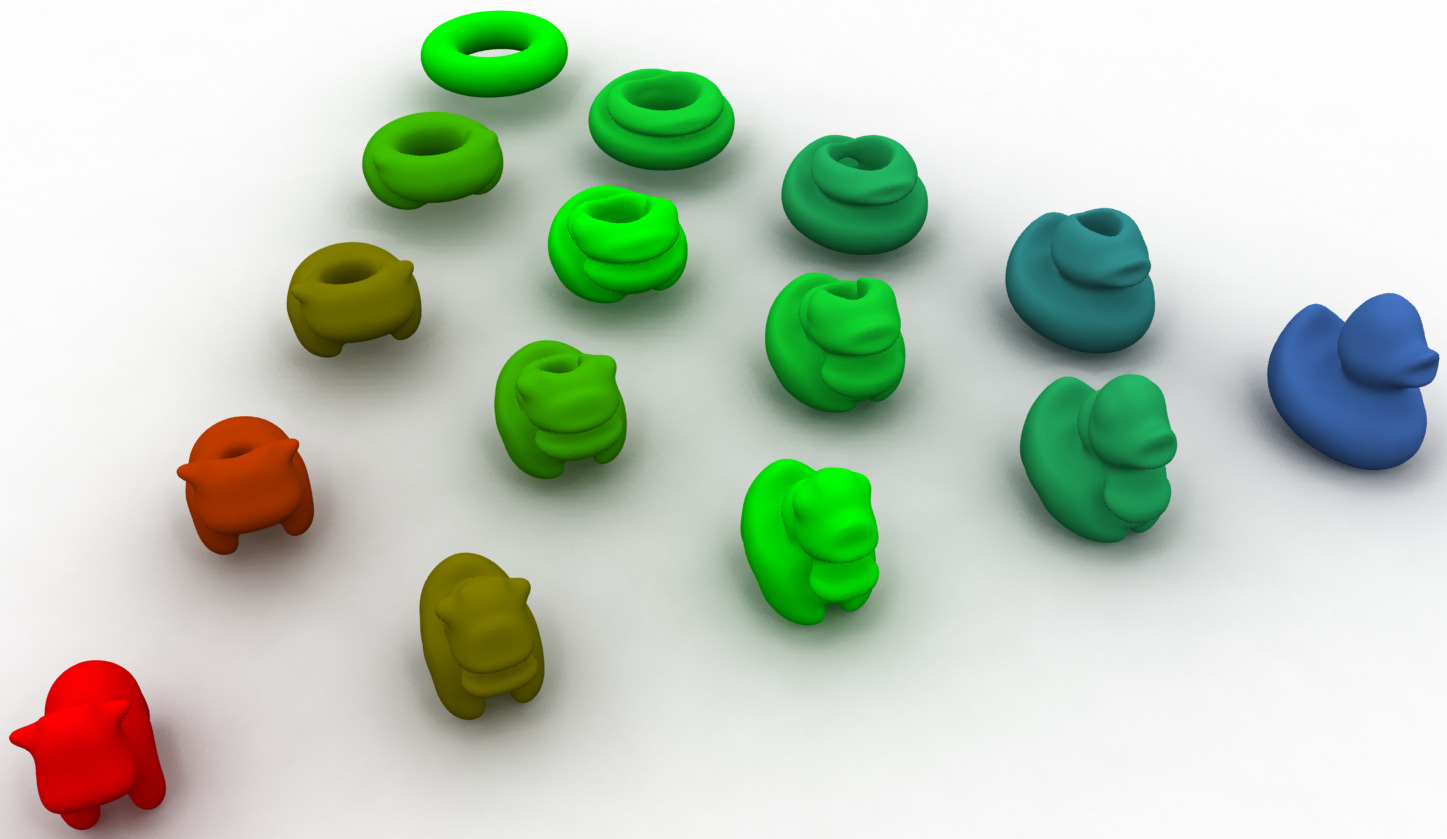
Seminar
Optimal Transport in Image Processing
Winter Term 2015/16
Home
About Us
People
Teaching
Research
Publications
Awards
Links
Contact
Internal
Hauptseminar Optimal Transport in Image Processing
Martin Schmidt,
Prof. Joachim Weickert
Winter Term 2015/16
(Main) Seminar (2 h)
Notice for bachelor/master students of mathematics: This is a »Hauptseminar« in the sense of these study programs.

|
| shape interpolation [1]. |
Important Dates – Description – Registration – Requirements – Overview of Topics
Deadline for writeup submission:
Mar 7, 2016, 10 am
Please register in HISPOS until October 30, 2015.
Regular meetings during the winter term 2015/16:
Monday, 4:15 pm.
Introductory meeting (mandatory):
The introductory meeting took place
on Thursday, July 30, 2015, 2:15 pm in E1.7, room 4.10.
In this meeting, we assigned the topics to the participants.
Contents: In recent years, optimal transport techniques became more and more popular. Although the basic ideas are intuitive and easy to understand they give rise to state-of-the-art methods. The goal of this seminar is to introduce and discuss optimal transport based algorithms in the context of image processing. Possible topics include
- colour transfer between images
- shape interpolation
- segmentation
- image decompositions
- image retrieval
- dithering
- and many more.
Prerequisites: The seminar is for advanced bachelor or master students in Visual Computing, Mathematics or Computer Science. Basic mathematical knowledge (e.g. Mathematik für Informatiker I-III) is required, and some knowledge in image analysis is recommended.
Language: All papers are written in English, and English is the language of presentation.
The registration period is over.
The seminar is full, there are no more places left.
Please do not forget to register also in the HISPOS system.
Regular attendance: You must attend all seminar meetings, except for provable important reasons (medical certificate).
Talk:
Talk duration is 30 min, plus 15 min for discussion. Please do not
deviate from this time schedule.
You may give a presentation using a data projector,
overhead projector or blackboard, or mix these media appropriately.
Your presentation should be delivered in English. Your slides and your
write-up, too, should be in English.
Write-up: The write-up should summarise your talk, about 5 pages per speaker will be adequate in most cases. Electronic submission is preferred. File format for electronic submissions is PDF – text processor files (like .doc) are not acceptable. Do not forget to hand in your writeup, because participants that do not submit a writeup cannot obtain the certificate for the seminar!
Plagiarism: Adhere to the standards of scientific referencing and avoid plagiarism: Quotations and copied material (such as images) must be clearly marked as such, and a bibliography is required. Otherwise the seminar counts as failed.
Mandatory consultation: Talk preparation has to be presented to your seminar supervisor no later than one week before the talk is given. It is your responsibility to approach us timely and make your appointment!
No-shows: In case you do not appear to your scheduled talk, we reserve the right to exclude you from all future seminars of our group.
Participation in discussions: The discussions after the presentations are a vital part of this seminar. This means that the audience (i.e. all paricipants) poses questions and tries to find positive and negative aspects of the proposed idea. This participation is part of your final grade.
Being in time: To avoid disturbing or interrupting the speaker, all participants have to be in the seminar room in time. Participants that turn out to be regularly late must expect a negative influence on their grade.
We plan to discuss the following papers. If your registration was successful, the password will be sent to you before the first meeting.
-
Solomon, Justin, Fernando de Goes, Gabriel Peyré, Marco Cuturi,
Adrian Butscher, Andy Nguyen, Tao Du, and Leonidas Guibas.
Convolutional Wasserstein Distances: Efficient Optimal Transportation on Geometric Domains.
SIGGRAPH 2015, Los Angeles.
Last update: Dec 1, 2015
MIA Group
©2001-2023
The author is not
responsible for
the content of
external pages.
Imprint -
Data protection